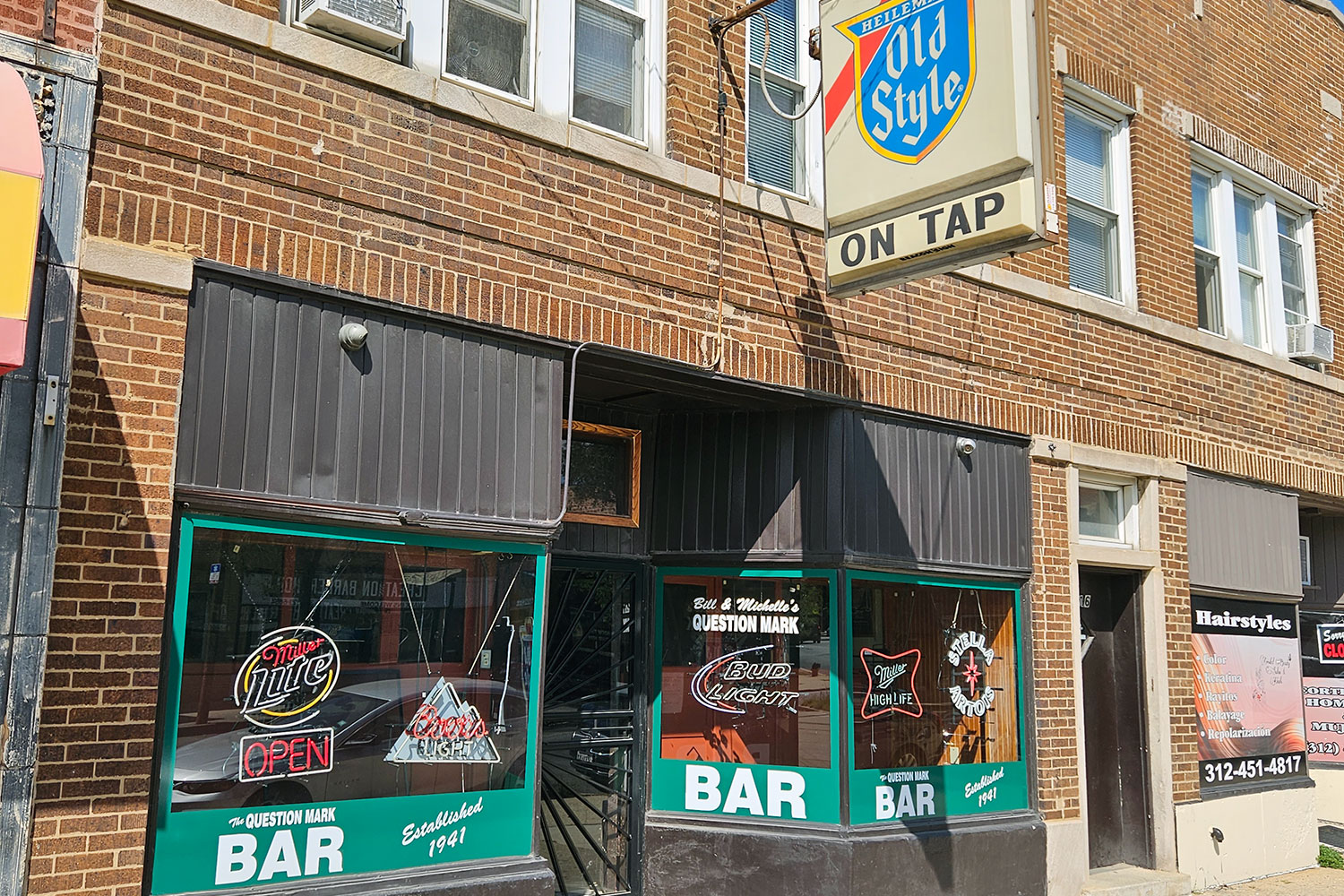The tavern keeper sat all alone at his bar on Labor Day afternoon. No one wants to drink indoors on a sunny afternoon. No one wants to drink indoors on a cold, dreary night, either, which is why taverns like the Question Mark, on Grand Avenue in Montclare, are dying out.
“You new in the neighborhood?” Bill Honquest asked me when I sat down to order a $2.25 pint of Miller Lite. At the Question Mark, it’s an occasion when a stranger stops in.
“Just out for a bike ride,” I explained. “Got thirsty. Is this the oldest bar in the city?”
“Established 1941” is painted on the Question Mark’s window. Behind the glass is a Chicago Daily Tribune front page from World War II, with the headline “PATTON DRIVES 27 MILES.”
“One of ’em,” Honquest said. “We’re an antique.”
Indeed, if the Chicago History Museum ever wants to mount an exhibit on the neighborhood tavern, it can simply transport the Question Mark to Clark Street. There is, of course, an Old Style sign dangling above the door. A pressed tin ceiling above drinkers’ heads. Miller High Life, PBR, MGD, and Lite on tap. Mass cards for departed regulars displayed behind the bar, beneath a “Trump Today, Trump Tomorrow, Trump 2020” bumper sticker. Ten stools, some with backs, some without. A pool table, a jukebox, a video poker machine, a television, an American flag on the wall, and a sign declaring that the Question Mark is cheap “and proud of it.”
“I need to raise the prices to $2.50,” Honquest grumbled, but the Question Mark has been cheap so long that keeping up with inflation might threaten its identity.
Honquest has been a regular at the Question Mark since 1970, shortly after he moved in across the street, and proprietor for the past 25 years. He bought the bar from an old woman who ran it after her husband died, and figures he’s the third or fourth owner. The name of the publican who poured the first pint, thousands and thousands of drafts ago, has been lost to history.
The Question Mark is the only tavern on this block, which it shares with the Mont Clare Masonic Temple, another antique, but it wasn’t that way when Honquest started drinking.
“There used to be 50 bars between here and Oak Park Avenue,” he said. “Now, there’s maybe four. There’s hardly any bars left of Western. There used to be 3,000 bars in the city of Chicago. Now there’s maybe 1,000.”
The disappearance of the neighborhood tavern is an old, old story in Chicago: It was the subject of Mike Royko’s very first Chicago Daily News column, published 60 years ago this month, on September 6, 1963. “Tavern Gets Taken For a Ride, and a Taxi Driver Mourns,” purported to be an interview with a tavern keeper who’d gotten out of the business and was now driving a cab. Royko might have invented the entire conversation, but it was with a breed he knew well. Royko’s father owned a tavern on Milwaukee Avenue, and he proudly described his upbringing as that of a “flat-above-the-tavern kid.”
“Today, what kind of places do people go to?” the tavern keeper-turned-cabbie lamented. “Places without any lights. They mess up their stomachs with fancy drinks. And it ain’t the whiskey that kills ’em, it’s the other stuff they mix in — juice and stuff. Another thing. People are moving out into the suburbs and that makes it tough on the neighborhood guy. I was thinking of opening up another place. But where? I looked around that Old Town neighborhood, but I couldn’t stand running one of those joints. You got to play long hair music on a record player. And people sit around playing chess. Then these goofy folk singers come in and play guitars. At least if it was an accordion…”
Yuppies. Suburbanization. Hipsters. Royko saw every threat to the traditional neighborhood tavern coming back in 1963. And this was at a time when there were still 3,000 bars in Chicago. They sponsored sports teams. They hosted wakes and wedding receptions. They provided dads a place to hide when families were larger and dwellings were smaller. Now, the figure is down to 809, according to Pat Doerr, director of the Hospitality Business Association of Chicago. The decline began even before Royko recorded it. The first cause was television. The second was deindustrialization.
“TV came along, and people didn’t have to use those neighborhood gathering places as much,” Doerr explained. “Bars that can open at 8 a.m. and bars that close at 4 a.m. or 5 a.m. are kind of a holdover from when we were a three-shift town. As manufacturing moved out, that also led to the decline, because you weren’t serving people leaving work all around the clock.”
(In 1937, there were 60 taverns operating in the Bush, the neighborhood outside the U.S. Steel South Works gates.)
Mayor Richard M. Daley, who took office in 1989, was “no friend of the tavern,” Doerr said: 800 closed during his 22 years in office. Daley allowed alderpeople to institute moratoriums on the issuing or sale of tavern licenses without their consent. He encouraged latter-day prohibitionists such as Rev. James Meeks in their efforts to vote South Side precincts dry. Then came online dating, which killed the singles bar. And the COVID-19 pandemic, which forced people to drink alone. Sixty bars have shut down since February 2020. COVID was bad for the Question Mark’s business.
“This used to be a busy place,” said Honquest on his barstool. “Then the pandemic came. We had to shut down. People stopped coming.”
They haven’t come back. At least they hadn’t on Labor Day. I left the Question Mark to get back on my bike, leaving Honquest alone in his bar near the edge of the city, near the end of the era of the neighborhood tavern.



